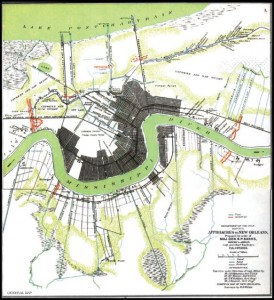
1863 Map of the City of New Orleans. Almost all of the developed area is on the high levee of the Mississippi River. The area north of the Gentilly Ridge (the ENE trending road in the upper right part of the map) and south of Lake Pontchartrain was not developed in full until the advent of the National Flood Insurance program in the 1960s. The 1863 urban pattern is a good example of proper site selection in a hazardous environment. The stippled light green zones indicate very low lying swampy areas. Most of the land area of this map is now developed (with large areas currently abandoned due to Hurricane Katrina). Most of the pre-Katrina population of New Orleans could fit into a slightly larger area than this 1863 footprint if it were built out at the densities of the French Quarter.
The South generally takes a fairly laissez faire attitude towards land use planning. There is a well-ingrained distrust of the government telling people what to do with their land. In early settlement days, development was rarely intentionally placed in harm’s way. People had a much better innate sense of the land. When they came to the coast or built near rivers, they sought out the most protected sites and/or the highest ground (See 1863 map of City of New Orleans here). They also perhaps had a better sense of the limits of the land, and perhaps had less faith in the ability of technology or the government to bail them out when they got into trouble. Today, the resistance to government regulation continues, but there appears to be a greater expectation that the government can or should “fix” problems like coastal flooding. The result is that many more people are in harm’s way in hazardous coastal environments, without much of a disposition to have limits imposed on their activities in terms of where new development goes or how it is built.
Floodplain Management
At the state level there may or may not be a single agency that deals with coastal hazards and development issues. There is certainly no state agency comparable to FEMA at the state level in any of the Gulf states, at least in terms of scope and impact. The important point here is that local communities do have significant discretion in how they manage their NFIP programs, should they choose to do so. Click here to learn more about State and Local Floodplain Management…
Land Use
There is a very wide divergence relative to planning powers and authority between Florida and the rest of the Gulf Coast states, at both the state and municipal levels . Click here to learn more about the differences in State and Local land use policy…
Building Codes
 State Codes
State Codes
Where states have adopted building codes, they are based on one of the standard codes, usually the International Building Code (IBC) for commercial and multifamily structures, and the International Residential Code (IRC) for single and two-family structures. The latest version of these codes is 2015 (www.iccsafe.org), with wind and flood provisions also updated to 2015. Only Florida and recently Louisiana mandate state codes for both residential and commercial buildings for all municipalities, with specific requirements for counties or parishes on the coast and in high wind hazard areas. Mississippi recently mandated statewide commercial and residential code enforcement, but allowed an opt-out policy for jurisdictions which did not wish to participate. Alabama and has state codes that apply to state buildings and a few other buildings. Texas has no state building code for either residential or commercial structures in municipalities, but it does recommend adoption of the 2003 IBC and 2000 IRC for cities and counties. In unincorporated areas of the state, the 2006 IBC and IRC standards are required is a county wishes to implement land use regulation. Click here to compare statewide adopted building codes…
Local Codes
Fortunately, in spite of the fact that there are no statewide codes in effect in two of the Gulf states, cities and counties are free to adopt their own building codes. Click here to learn more about local governments adopting their own building codes…



